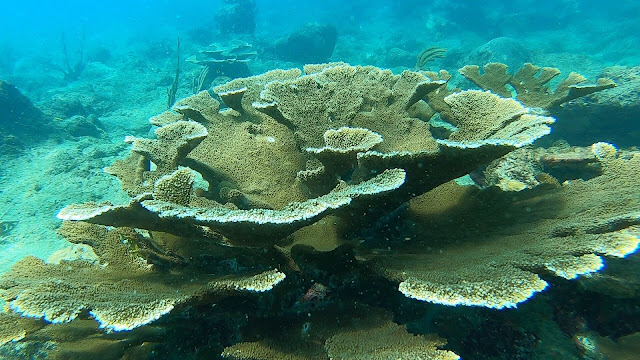Ocean as a Source of Life
Dr Anjani Ganase reflects on the ocean as a source of life; and the possibility that where there is water in the universe, there might be life.
Breathe in and out, look around, see life all around us. Life as we know it is the culmination of evolution that started over three billion years ago on this planet in our ocean. We have evolved enough to be able to trace our origins but also to seek out other origin stories in our solar system and beyond. Life requires the presence of energy, organic molecules to be organised and structures and water as the medium for chemical reactions and transport of elements and nutrients. Our planet is home to a large body of waters, the ocean occupies 70 % of planet earth. It is the keeper of climates and maintains life. Our planet received deposits of frozen water from space over billions of years from comets and asteroids colliding with the surface of the planet. As the planet warmed, the water collected to form the ocean. While water is common on other planets, as it resulted from the formation of the universe during the Big Bang, it is very common as water vapour or frozen as ice. Liquid water is rarer, so when seeking life, we must go where the water flows. We observe the water vapour through the Hubble telescope around stars and nebulas (space dust found where new stars are born). We also observed frozen ice on many planets and moons in our solar systems.
Scientists have been looking for liquid water throughout our solar system and even beyond it. Just looking at our neighbours, Mars’ atmosphere is thinner than earth. Evidence of liquid water is seen on the surface of Mars where water has eroded the surface with the formation of rivers and lakes leaving behind scars. Scientists speculate that the patterns came from an era where water existed in plenty but the thinning atmosphere likely resulted in the transport of water out of the atmosphere into space. What’s left are frozen ice caps giving some potential for microbial life. Our other neighbour, Venus was also suspected of housing an ocean, but similar to Mars, the thin atmosphere and a run-away planet climate (warming conditions) would have boiled the water out of the atmosphere.
Looking farther away in our solar system, scientists have sought out places where water exists with the hope that there may be flowing water and signs of life. Using sophisticated telescope technologies such as the James Webb Space Telescope or the Kepler telescope capable of detecting the full electro-magnetic spectrum from infrared, visible light to ultraviolet and gamma rays to discern the chemical compositions of planets faraway. Frozen water can be found on several moons around Jupiter and Saturn. Moons of Jupiter - Europa and Ganymede –are homes to subsurface oceans buried under layers of ice. On Europa, the heat from Jupiter creates enough warmth for the surface water melt creating lakes. A potential life starter. In contrast, on Callisto, another moon of Jupiter, the ocean lies 200 km below a thick crust of ice. Enceladus, a moon of Saturn, has a large ocean below the icy surface, but there are very large vents that are fracturing the surface of the moon, and emitting spouts of water into space. The Cassini spacecraft was flown through the sprays collecting information of the water content which included a mixture of organic matter, ammonia and carbon dioxide. These vents have the making for the start of life, similar to the hydrothermal vents on our planet, where life forms were created from chemosynthesis.
Beyond our solar systems the strategy for finding life changes a little based on the limitations of our technology. Scientists seeks out planets with similar planetary conditions to Earth, such as its distance from their star (sun), characteristics of the star it orbits, and the planet’s orbital path. The Kepler telescope has identified several planets with earth-like qualities. Kepler 22-b, nicknamed super earth, is 2.4 times the size of Earth, and located in the habitable distance from the star, but the composition of the planet is still unknown. Then there is Kepler-453b orbiting a star that is 10 % larger and 20 % brighter than our sun The planet is also 60 % bigger, and orbits in 385 days. The age of this planet is 6 billion years, a littler older the Earth.

Europa's
Mysterious Interior (Artist's Concept) with a subsurface ocean below a layer of
ice. Credit: NASA/JPL-Caltech
Much of the exploration for life outside Earth is based on the premise that life on another planet would evolve in a similar fashion to how it evolved on Earth. This is certainly the most practical place to start given the seemingly infinite number of possibilities of observations in our universe. However, it is also possible that life may have formed completely independent of water and compounds used in the biosphere of this planet. How do we even comprehend or evaluate this possibility? With maths, modelling, and a little imagination, astrobiologists explore alternative origins of life, that may use a different medium other than water, and alternative building blocks. Instead of looking at a planet similar to ours. We can instead explore the conditions of the planet and model possibilities of what life might look like, if it were to evolve.
It is a type of biology that we often apply here at home, when we explore the unseen depths of our oceans or the most inhospitable places on the planet, such as extremophiles found in deep ocean sediments, volcanoes and acid lakes. It is exciting for marine biologists to be able to imagine other worlds of adaptations and interactions between the life forms and the environment they live in. Clearly, the question is something that many of us find relevant, since we benefit from the sophisticated technology which is devoted to exploring far reaches of solar systems when applied to the ocean. Looking out to the sky allows us to appreciate and understand the relative uniqueness of planet earth, this blue marble of life and the need to protect it.
References: Ocean Worlds: Water in the Solar System and Beyond https://science.nasa.gov/solar-system/ocean-worlds/




